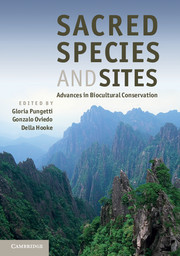Book contents
- Frontmatter
- Contents
- List of Contributors
- Foreword
- Preface
- Acknowledgements
- Introduction
- Part I Concepts and Knowledge
- Part II Sacred Landscapes
- Part III Sacred Sites and People
- Part IV Sacred Species
- Part V Sacred Animals
- Part VI Sacred Groves and Plants
- Part VII Implementation and Conclusions
- Index
- Plate Section
- References
Introduction
Published online by Cambridge University Press: 05 August 2012
- Frontmatter
- Contents
- List of Contributors
- Foreword
- Preface
- Acknowledgements
- Introduction
- Part I Concepts and Knowledge
- Part II Sacred Landscapes
- Part III Sacred Sites and People
- Part IV Sacred Species
- Part V Sacred Animals
- Part VI Sacred Groves and Plants
- Part VII Implementation and Conclusions
- Index
- Plate Section
- References
Summary
Conservation of biocultural diversity
The year 2010 was declared by the United Nations (UN) as the International Year of Biodiversity, indicating its now widely accepted vital importance. The conservation of biodiversity – the variability and diversity of living organisms on the planet – is fundamental to the health, resilience and sustainability of life on Earth. At a time when many species have been driven to extinction as a direct result of the actions of humankind, with many more similarly threatened, conservation of biodiversity is one of the challenges of our century.
Yet, while the importance of biodiversity and its conservation increasingly gathers momentum, attention is now being drawn to the importance of preserving ‘biocultural’ diversity, as confirmed for example by the ‘Biocultural Diversity Journey’ at the IUCN World Conservation Congress in Barcelona in 2008 (McIvor et al., 2009) and the publication in 2010 of Biocultural Diversity Conservation: A Global Sourcebook (Maffi and Woodley, 2010). The Convention on Biological Diversity also convened in 2010 the ‘International Conference on Biological and Cultural Diversity: Diversity for Development – Development for Diversity’, with the aim of advancing development of a programme of work on the subject (Convention on Biological Diversity, 2010).
The UNESCO Universal Declaration on Cultural Diversity (UNESCO, 2002) reaffirms that ‘culture should be regarded as the set of distinctive spiritual, material, intellectual and emotional features of society or a social group, and that encompasses, in addition to art and literature, lifestyles, ways of living together, value systems, traditions and beliefs’ (p. 12).
- Type
- Chapter
- Information
- Sacred Species and SitesAdvances in Biocultural Conservation, pp. 1 - 10Publisher: Cambridge University PressPrint publication year: 2012
References
- 1
- Cited by

